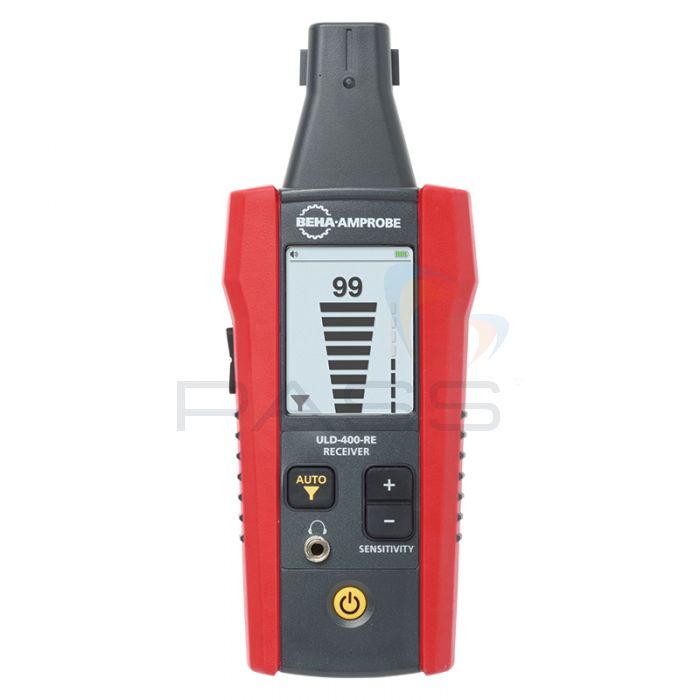Beha-Amprobe ULD-400-RE Receiver

- Pinpoint the source of leaks, vibration and electrical discharge
- Range: 20kHz to 90kHz
- Adjustable sensitivity and filter function
The Beha-Amprobe ULD-400-RE Receiver is an ultrasonic detector that can be used to pinpoint the source of leaks, vibration or electrical discharge in HVAC/R, mechanical and electrical systems. Please see the following video for a quick introduction to Beha-Amprobe ULD-400-EUR Series of Ultrasonic Leak Detectors.
The Beha-Amprobe ULD-400-RE Receiver converts ultrasonic sound emitted by equipment failure into a visual and audible signal that can be used to locate the fault. The ultrasonic signal’s strength is indicated via a bar graph on the Beha-Amprobe ULD-400-RE Receiver’s LCD 6.35cm display. The user can also trace the source of the leak by listening to the converted audible sound via the headphones. Additionally, using the headphones the operator is able to identify the type of fault detected: air leaks issue a hissing sound while electric discharge creates a ticking noise. Please see the video below for a brief overview of how to use the Beha-Amprobe ULD-400-RE Receiver.
The Beha-Amprobe ULD-400-RE Receiver has a frequency range of 20kHz to 90kHz enabling it to detect a variety of leaks. The Beha-Amprobe ULD-400-RE Receiver also features adjustable sensitivity and is equipped with a filter function for removing up to three main noise frequencies, allowing the user to find faults in noisy environments. Please see the following video for further information.
Further to this, the Beha-Amprobe ULD-400-RE Receiver is compatible with a range of accessories and tools designed to improve the precision and ease with which faults and leaks can be detected. A parabola accessory (NOT included) works to direct ultrasound towards the sensor while a detachable tubular extension (NOT included) provides access to hard to reach areas. Additionally, the Beha-Amprobe ULD-400-RE Receiver can be used with the Beha-Amprobe ULD-400-TE Transmitter (NOT included) to find leaks in unpressurised systems; the transmitter boosts the ultrasonic signal allowing the receiver to find the source of the fault. Please see the video below for more information
The Beha-Amprobe ULD-400-RE Receiver is a useful ultrasonic diagnostic tool. It can be used to inspect compressed air and other gases,** plumbing, electrical and mechanical systems, valves, tanks and pipes, heat exchangers, boilers and condensers, air conditioning and refrigeration systems, and motors and machinery.
Beha-Amprobe ULD-400-RE Receiver Key Features
- Ultrasonic detector for pinpointing the source of leaks, vibration and electrical discharge
- Can be used in HVAC/R, mechanical and electrical systems
- Converts ultrasonic sound into an audible and visual signal
- Bar graph indicates the strength of the ultrasonic signal
- 6.35cm LCD display
- Trace the source of the leak by listening to the converted audible sound via the headphones
- Audible sound can be used to help identify the type of fault
- Air leaks issue a hissing sound
- Electric discharge issues a ticking sound
- Frequency range: 20kHz to 90kHz
- Adjustable sensitivity
- Filter function: remove up to three main noise frequencies to find faults in noisy environments
- Use with a parabola accessory (NOT included) to direct ultrasound towards the sensor
- Use with a detachable tubular extension (NOT included) to access hard-to-reach areas
- Use with the Beha-Amprobe ULD-400-TE Transmitter (NOT included) to find leaks in unpressurised systems
- The Beha-Amprobe ULD-400-TE Transmitter boosts the ultrasonic signal allowing the receiver to find the source
- Useful ultrasonic diagnostic tool
- Inspect compressed air and other gases
- Inspect plumbing
- Inspect electrical and mechanical systems
- Inspect valves, tanks and pipes
- Inspect heat exchangers, boilers and condensers
- Inspect air conditioning and refrigeration systems
- Inspect motors
- Inspect machinery
What’s Included?
- Beha-Amprobe ULD-400-RE Receiver
** Please note that the Beha-Amprobe ULD-400-RE Receiver CANNOT be used for combustible gas leak detection.
Call 01642 931 329 or complete the form:
Offers
 Spend £150+ (Ex VAT) on any qualified Fluke or Beha-Amprobe product(s) and claim a free tool of your choice from the list at Fluke Promotion. Valid February 17 2025 - July 31 2025.
Spend £150+ (Ex VAT) on any qualified Fluke or Beha-Amprobe product(s) and claim a free tool of your choice from the list at Fluke Promotion. Valid February 17 2025 - July 31 2025.
Claims are made direct to Fluke. Terms and conditions apply.
Beha-Amprobe ULD-400-RE Receiver Technical Specifications
| Sensitivity Adjustment | Yes |
| Volume Adjustment | Yes |
| Signal Level Adjustment | N/A |
| Earphone Jack (3.5 mm) | Yes |
| Display Size | LCD 2.5 in (6.35 cm) |
| Display Dimensions | 1.45 x 1.93 in (36.72 x 48.96 mm) |
| Display Resolution | 240(RGB) x 320 pixels |
| Display Type | TFT-LCD (262 K) |
| Display Colour | True, 16bit/colour |
| Frequency Range | 20 kHz to 90 kHz |
| Filter | ±5 KHz of main noise frequency, up to three filters |
| Power Supply | 4 x 1.5 V AA (LR6) alkaline batteries |
| Power Consumption (typical) | 75 mA |
| Battery Life (typical) | 105 hours (Alkaline) |
| Low battery indication | Yes |
| Weight | Approx. 0.518 lb (0.235 kg) |
| Dimensions | 7.547 x 2.984 x 1.791 in (183 x 75 x 43 mm) |
| APO function | 60 minutes when in idle |
| Operating Temperature | -4 °F to 122 °F (-20 °C to 50 °C) |
| Storage Temperature | -4 °F to 158 °F (-20 °C to 70 °C) |
| Operating Humidity | <80% RH |
| Pollution Degree | 2 |
| Protection | IP40 |
| Certifications | |
| Electromagnetic Compatibility (EMC) | EN 61326-1 |
| Korea (KCC): Class A Equipment (Industrial Broadcasting & Communication Equipment) [1] [1] This product meets requirements for industrial (Class A) electromagnetic wave equipment and the seller or user should take notice of it. This equipment is intended for use in business environments and is not to be used in homes. |




